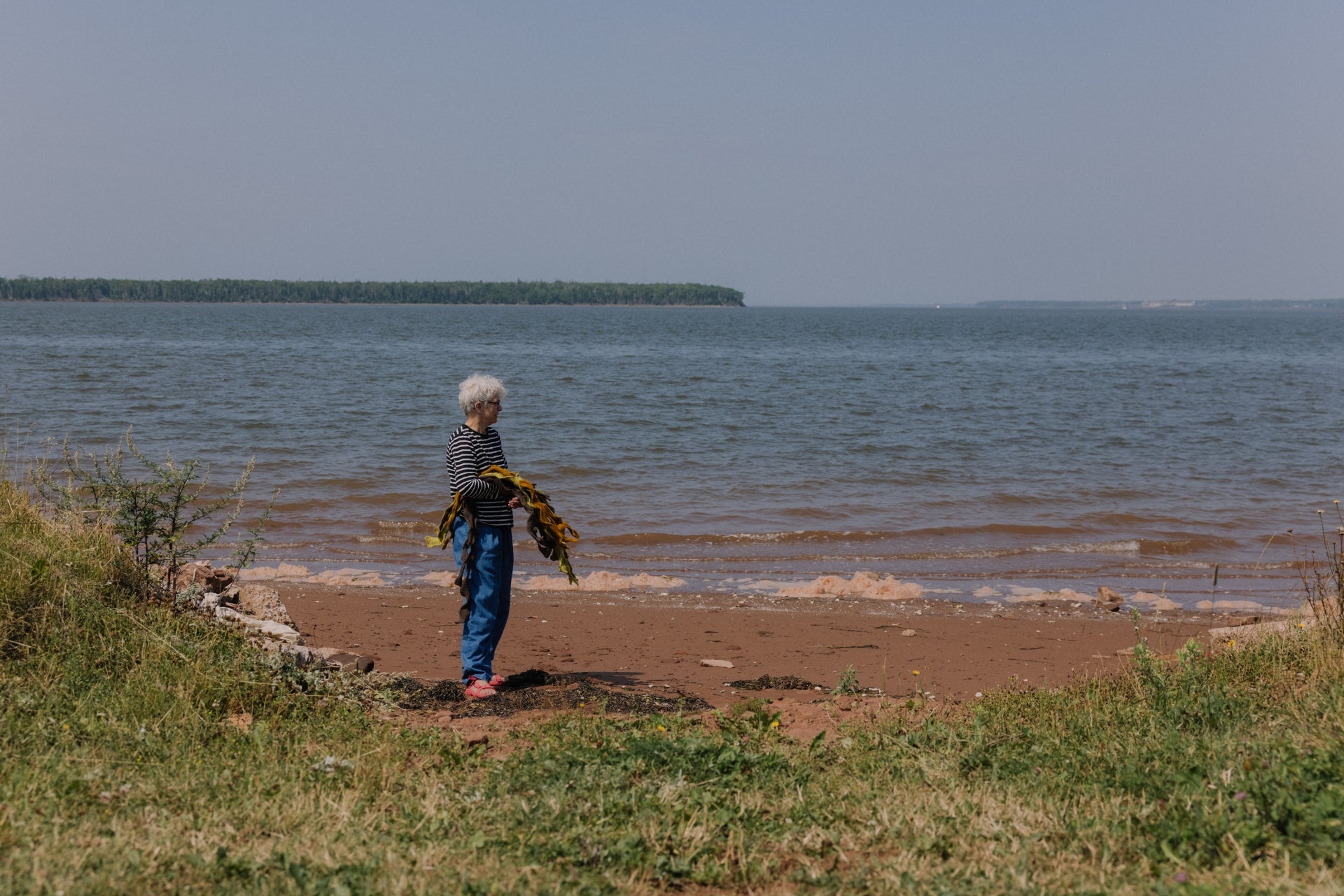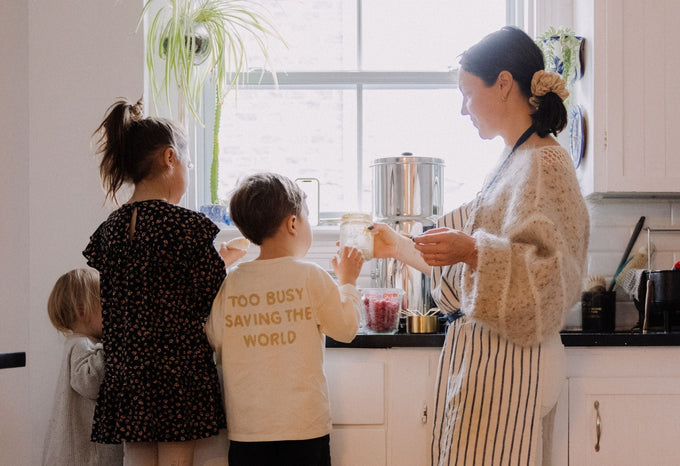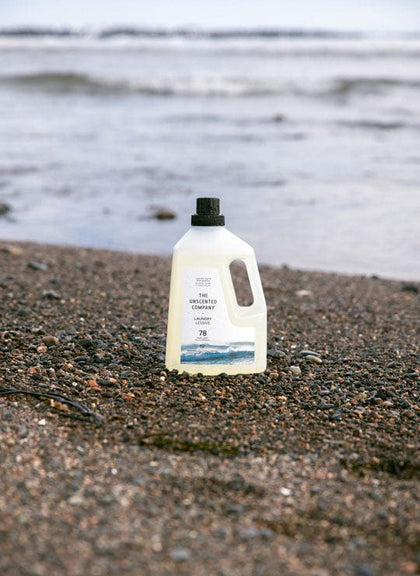In Summerside, Prince Edward Island, nestled in a tree-lined courtyard, you’ll find the home of Jane Whitten. A basket woven from plastic ribbons hangs by the house number — the first sign you’re entering the artist’s creative realm. There’s no doubt about it: I’ve arrived at the doorstep of the contemporary basket weaver and knitter. The salty scent of the nearby ocean surrounds me, carried here by the breeze.
Jane welcomes me into her home, a lively space where creativity is woven into daily life. Works in progress line the tables, shelves, and even the floor — a testament to creativity in constant motion. With a wry smile, Jane tells me she’s learned to work with her wandering attention, seeing it not as a hindrance but as fuel to ward off boredom. She “plays,” as she likes to put it, experimenting with materials and techniques to produce pieces that blur the boundary between function and whimsy, using both time-honoured and unexpected elements.

At first glance, her work draws you in with its delicacy: woven tubes, spiraling forms inspired by the natural world, subtle textures. There’s beauty in the detail, a painstaking precision that holds your gaze. But step in closer, and something unexpected reveals itself. Her pieces aren’t crafted from traditional fibers, but from pliable plastics: packaging bags, clothing tags, and other scraps pulled from the overflow of our hyper-consumerist culture. What seems organic is, in fact, synthetic. And it’s within that tension — between the familiar and the unsettling, between handcrafted elegance and the discarded materials of our time — that Jane’s vision takes shape.
Her home feels quietly attuned to the elements, as if each fibre of her work holds the memory of the shorelines she’s walked. Though born in Canberra, Australia, it was along the North Atlantic coasts — from Maine to Newfoundland, through Nova Scotia and Prince Edward Island — that an invisible thread was woven between her life and her art.
“I’ve always been drawn to North Atlantic culture, especially the way islanders find ways to adapt to such harsh and sometimes extreme conditions,” she recalls. “That’s what led me to study in Newfoundland. I wanted to immerse myself in those resilient communities that inspired me — to live among them rather than observe them from afar.”
Before devoting herself fully to art, Jane spent several years teaching in northern Newfoundland — first in primary school classrooms, then in special education. That parallel path allowed her to develop approaches tailored to students who, like her, didn’t fit neatly into traditional moulds. “I’ve always believed that everyone learns differently. Teaching taught me to slow down, to look at things from another perspective. And that attentiveness is something I’ve carried with me into my artistic practice.”
Though she’s always considered herself a craftsperson, it was in Nova Scotia in the 1990s that she discovered basketry and the world of craft guilds. “I was immediately fascinated by the relationship between function and form. A basket is both utilitarian and beautiful. It’s a structure, a volume, a vessel — but also a memory, a way of understanding a place.”
She soon turned to materials gathered along the shoreline. “My son was only four at the time. When I crouched down to his level, I started noticing things adults tend to overlook — washed-up seaweed, tiny forgotten details in the sand.” She eventually developed a homemade, non-toxic solution to preserve the seaweed and began weaving it into baskets. Some of the seaweed she works with today was harvested and treated nearly thirty years ago.

But before long, plastics — everywhere, inescapable — began to demand her attention. “Traditionally, basket weavers use the materials they find around them. If there’s enough at hand, all you need to do is figure out how to weave, coil, or assemble them into a basket.”
So Jane began collecting, sorting, cutting, and weaving the discarded remnants of our consumer culture — not to conceal them, but to reveal them. She makes these materials visible, even elevates them, not to embellish but to stir awareness. “I’m always a little worried about making plastic too beautiful,” she admits. “But without a touch of wonder, people won’t stop to look. And if we don’t look, we can’t begin to reflect.”
During the pandemic, she created an especially striking piece, now part of the Canada Council Art Bank collection. “I made cylindrical vessels from the single-use packaging I threw away each month while living alone. Each item was recorded in a notebook as I discarded it, then integrated into the piece in chronological order. Over time, it grew into a kind of portrait of my consumption, amplified by the online shopping I did during COVID.”
Jane then shows me her quilts stitched together from reclaimed plastic bags. Some are more than thirty years old — mostly potato chip wrappers she’s carried with her across the countries where she’s lived. Their pristine condition, despite the passing of time, is a quiet testament to the unsettling permanence of plastic.

On a table, tiny blue mussels, almost indistinguishable from their living counterparts, wait to be woven one by one. Made from chicken-pie packaging by the local company Handpie, a favourite of hers, Jane wraps them around metal wire, then stitches them together with fresh dental floss. “Mussels have long been a food source on Prince Edward Island. But their survival depends on clean water,” she explains. “Today, climate change is threatening their yields. Plastic plays a major role — from microplastics in the ocean to rising water temperatures and more frequent extreme weather events.”
Each mussel takes her six to ten hours to complete. She’s currently preparing several for an upcoming exhibition in Nova Scotia. It’s a slow, methodical rhythm, running counter to the frenzied pace at which we consume and discard.

We walk down to the beach, just steps from her home. Jane points out the sand scattered with fragments of oyster shells, which she’s used in her Island Wanderings series — small pots she calls Islets, hand-knit from cotton inlaid with sand and set with her famous “magic potion.” Despite their fragile appearance, the sculptures are solid, almost indestructible. They speak to the critical state of the island’s oysters, now threatened by an invasive parasite.
Her seaweed-like wool sculptures, textured with recycled ping-pong balls from her daughter, highlight the importance of noticing the often-overlooked markers in our environment. These seemingly insignificant elements can in fact provide vital clues about the health of our ecosystem.
Each of her works becomes a marker of the present, a space where dialogue begins. “I can’t save the world, but I can change a perspective. One mussel at a time, one basket at a time, one exhibition at a time,” she says. Because Jane doesn’t just create: she teaches, she connects, she opens up small but meaningful gaps in our collective consciousness.
In a few weeks, she’ll fly to Norway, near the Russian border, for an artist residency with designer Ingrid Larsen. Together, they’ll gather seaweed, weave baskets, and reflect on the state of the Gulf Stream and the transformations shaping the North Atlantic. The same gestures. The same attentiveness to the living world. One stitch at a time.
I leave Jane filled with admiration. She is, without a doubt, an inspiring woman. On the way home, I catch myself seeing my own waste with new eyes. Could the bits of fishing rope I’ve picked up on the beach near my house also be given a second life? I make myself a quiet promise: one day, I’ll join Jane in one of her basket-making workshops, learning the patient art of weaving awareness, one stitch at a time.







